
By Jim Dunn
Professor of Agricultural Economics, Penn State University
Dairy prices have calmed down somewhat, although there is still uncertainty about what lies ahead. The dollar is showing continued strength, especially against the Australian dollar and between Russia and the Middle East, there is plenty of turmoil globally. With the strength of the dollar, fewer dairy imports by Russia, and a weaker Chinese economy, U.S. dairy exports are declining. Secondly, milk production continues to grow. Butter prices have dropped slightly, from $2.00/lb. to $1.985. Over the same period, block cheese prices ratcheted down, retreating from $2.00/lb. last month to $1.58/lb. now. Skim-milk powder price fell by 10.2% (13.2¢/lb.) following international prices down. The dry whey price is down 1.9% since last month. The net effect is that the cheese price dropped a lot, but dry whey did not, while the butter price dropped slightly, while skim-milk powder dropped a lot.
Table 1 lists some past and estimated future milk prices. The November Pennsylvania all-milk price fell by $1.30/cwt. from October to $24.80/cwt. The latest month's milk production growth was high, suggesting milk prices should fall this month as well, which is certainly reflected in the futures market. The November Class III price was down $1.88 from October at $21.94/cwt. The latest Class III futures price for December is $17.80, so milk prices will continue to fall until February. The average Class III futures prices for the first half of 2015 are $16.04, with slight growth for each successive month. The November Class IV price was down $3.14/cwt. from October at $18.21/cwt. The December Class IV futures price is $17.00/cwt. The forecast all-milk prices for the first half of 2015 average $19.01/cwt., or $6.92/cwt. below the same period of 2014.
The U.S. dollar is up against the Euro, the Australian and the New Zealand dollars since my last report, although not very much. The dollar is up 0.6% against the Euro. The dollar has risen by 26% against the Aussie dollar in two years, a very large change in exchange rates. Chinese export demand for U.S. dairy products has fallen off, in part because of a trade deal with Australia and also just because its economic growth rate has slowed.
Corn and Soybean Markets
Corn and soybean meal prices have fallen less than 1% since the last report, ending at $3.77/bu. for the December 2014 corn contract and $401.50 for December meal. Soybean prices are down 2.1% from last month. At this stage there is not much news on these markets since the crop is harvested and next year's crop is still in the distant future.
Income over Feed Costs (IOFC)
Penn State's measure of income over feed costs fell by 7.9% in November, but is still above last year. Figure 1 shows how these values compare to recent years.
This month's feed cost is 11¢/cow/day more than in October. November's value for IOFC of $11.17/cow/day is 9% above the November 2013 value of $10.25. The PA all-milk price was down $1.30/cwt. in November, while the feed costs rose by 2.4%, with higher prices for corn and soybean meal and lower prices for hay.
Income over feed cost reflects daily gross milk income less feed costs for an average cow producing 65 pounds of milk per day. Figure 1 and Table 2 showing the monthly data follow.
The allocation of the revenue per hundred pounds of milk is shown in Table 3. The milk margin is the estimated amount from the Pennsylvania all milk price that remains after feed costs are paid. Like income over feed cost, this measure shows that the November PA milk margin was 7.9% below October. With the all-milk price forecast to be $19.00/cwt. in 2015 and the feed cost to about $7.50 to $8.00, this leaves a milk margin of $11.00 to $11.50, values typical in the first half of 2013. This is not terrible, but well below the 2014 levels.
Milk Production
The latest milk production report showed October milk production up 3.8% from the year earlier, another sizeable monthly increase after many months of minimal growth (Figure 2). This is bearish, although the increase was expected. Once again, the growth in milk production was in milk per cow rather than cow numbers. The national dairy herd this October is only 0.83% greater than in October 2013. The monthly cow numbers is shown in Figure 3.

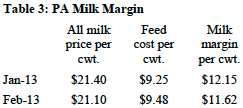
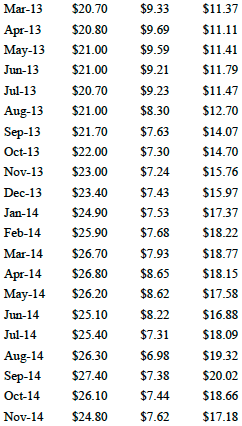
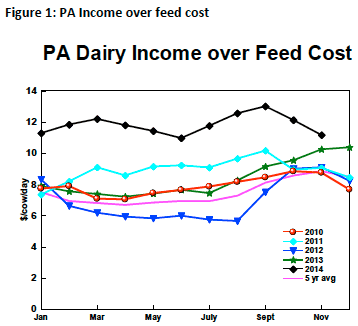
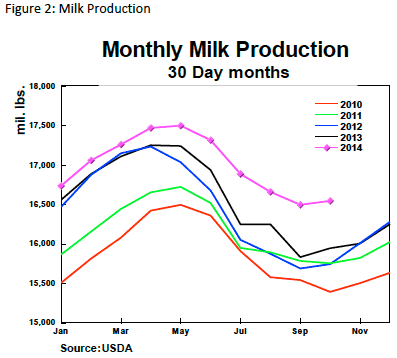
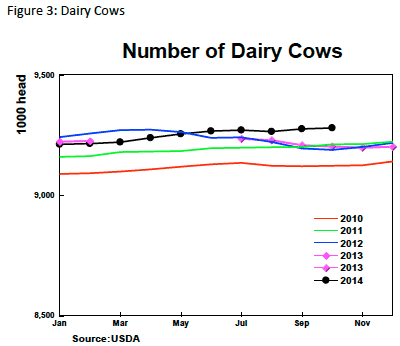
12.10.2014